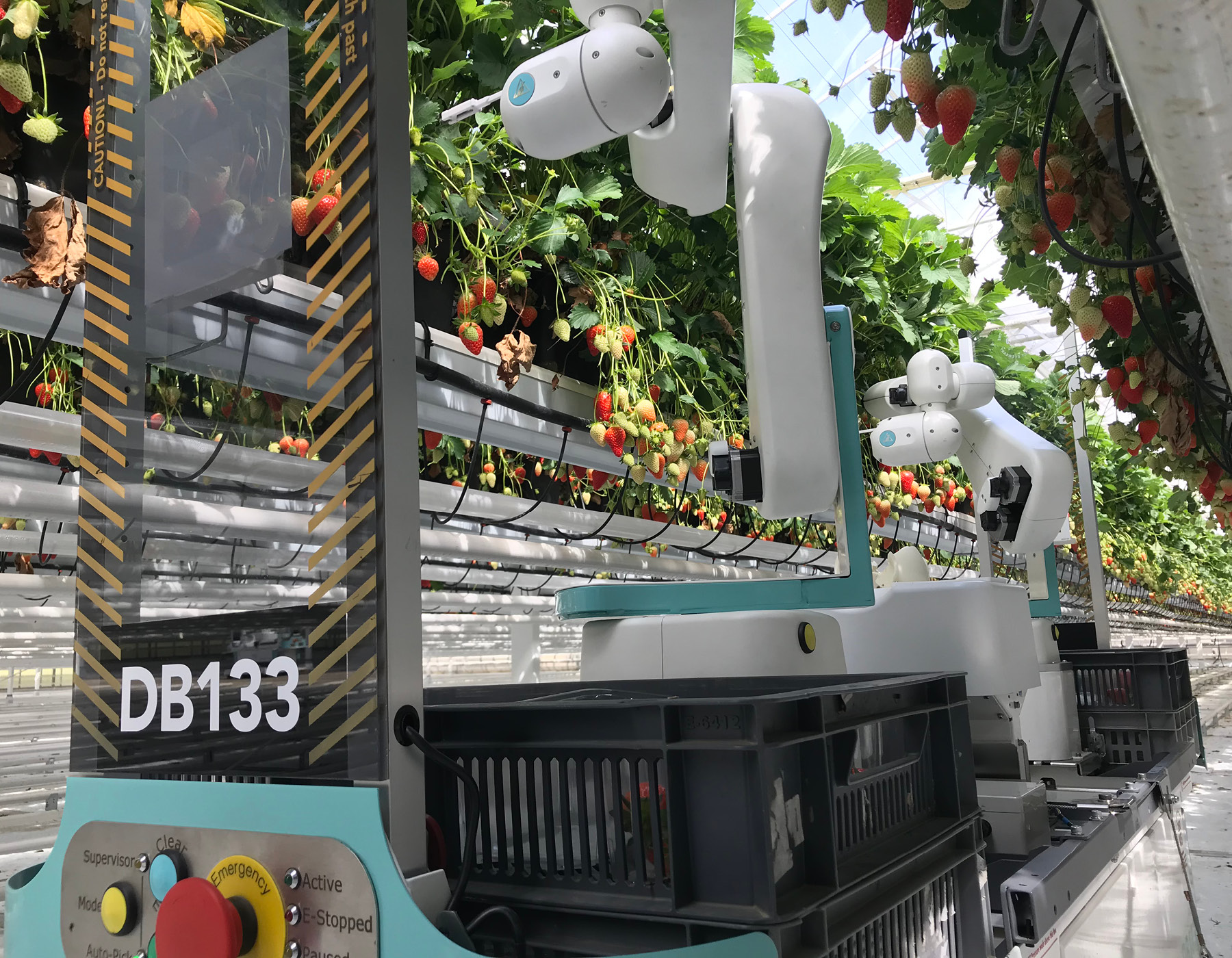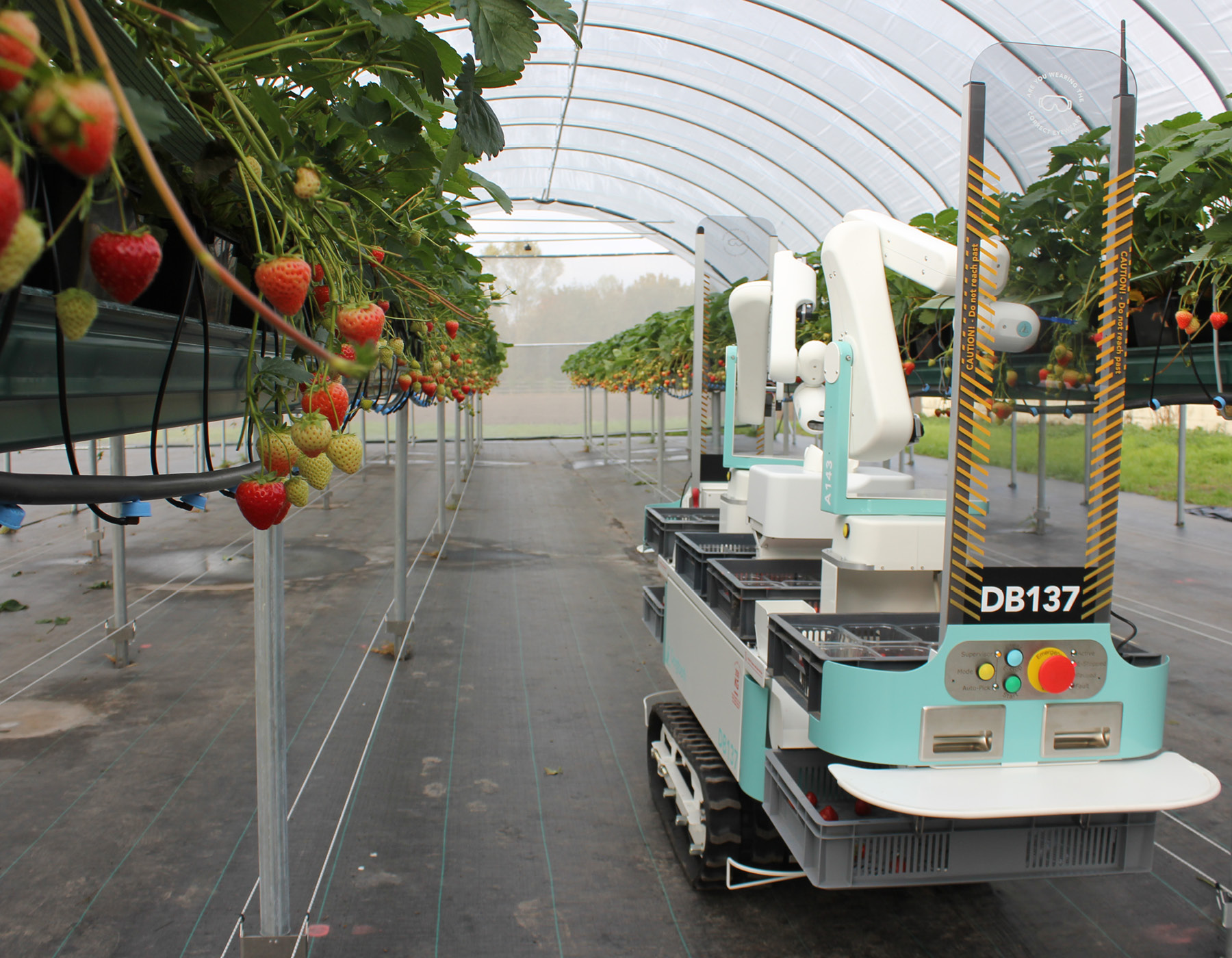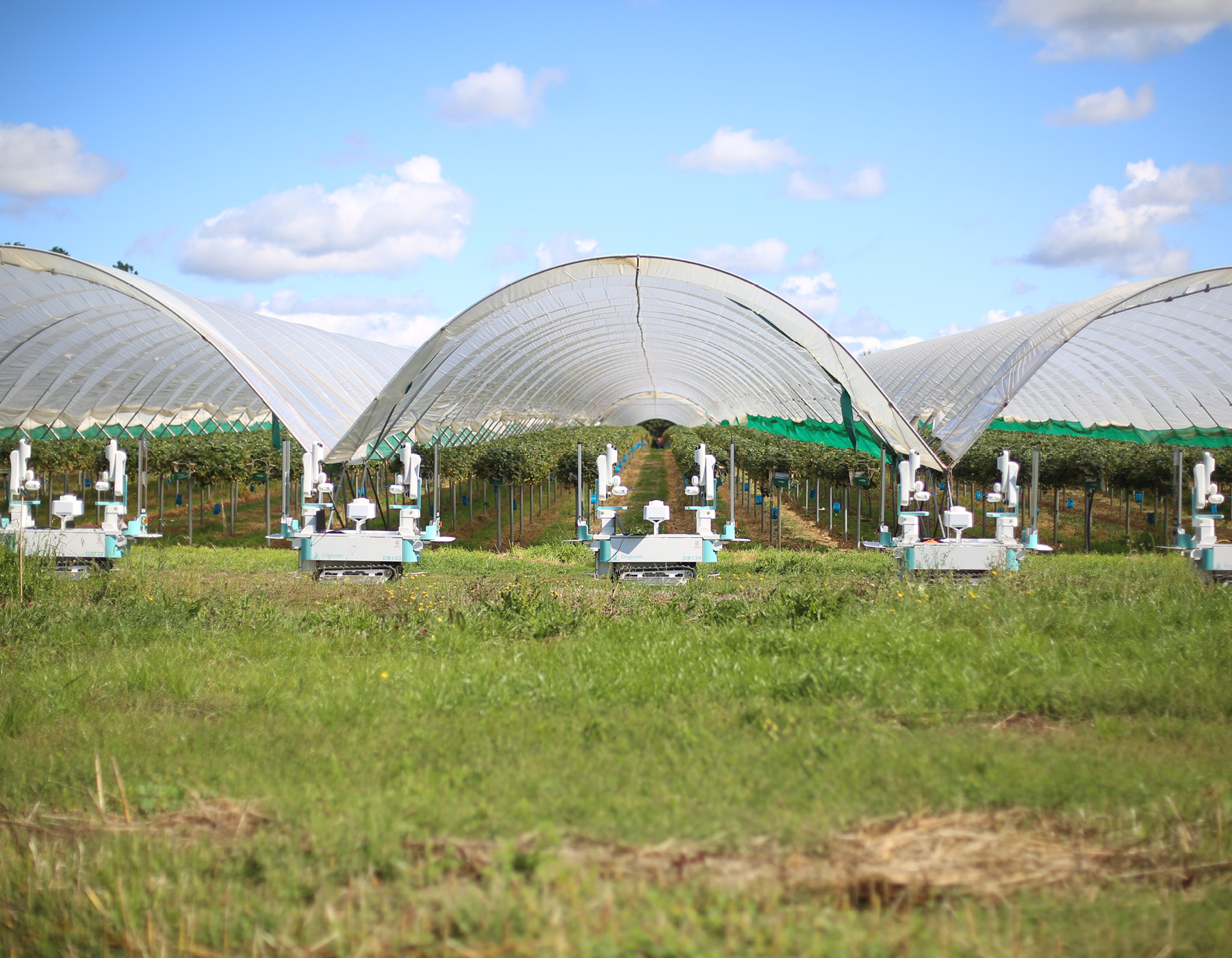Language
You can read the magazine in one of the following languages
Higher yields with fewer resources. That’s the challenge that farmers around the world are trying to solve. According to data from the United Nations, global food insecurity has reached 29 percent, which means more than one billion people are facing the issue.
Considering that the world’s population is expected to reach 10 billion by 2050, there will be a huge increase in demand for food. At the same time, the shortage of agricultural production is affecting food chains.
Farmers and ranchers report that they’re struggling to find people willing to harvest and process the food that’s produced, even if the search is extended outside their borders.

A Dogtooth robot harvests strawberries
In 2021, the UK National Farmers’ Union (NFU) wrote to then British Prime Minister Boris Johnson requesting the launch of a COVID-19 Recovery Visa to alleviate the shortage of labor throughout the supply chain.
In the United States, with a declining rural population and increasing opportunities outside the farm, many farmers have turned to bringing in labor from other countries through the H-2A agricultural visa program.
According to the Food and Agriculture Organization of the United Nations (FAO), 37.6 percent of the Earth’s land is dedicated to agriculture, and in countries such as Mexico, most of the use of water is in this sector (77 percent according to the Mexican national water authority, Conagua).
Sustainable use of land resources is crucial to mitigating climate change and biodiversity loss. Thanks to new technologies, farmers can contribute to making their food supply chain more sustainable by reducing their carbon emissions.
The use of drones, autonomous tractors and agricultural robots are some of the innovations that could be key to the future food supply.
“Until recently, agriculture has always been about doing more with more – more horses, more inputs, more hectares – but the digital age is changing all that. In the last decade, it has been about doing more with less and providing farmers with tools to make informed decisions,” said Jahmy Hindman, Chief Technology Officer of John Deere, the world’s largest manufacturer of agricultural machinery, speaking at the launch of its first 100 percent autonomous tractor in Las Vegas.

“Until recently, agriculture has always been about doing more with more – more horses, more inputs, more hectares – but the digital age is changing all that.”
- John Deere CTO Jahmy Hindman
Driverless tractors aim to free farmers from 8–12 hours of driving by controlling the tractor through an app on their phone or computer. The farmer can use the app to place the tractor where it needs to be, drive along a field, turn around, come back, as well as maneuver it to navigate obstacles.
The company has not said how much these tractors will cost or when would they be available in the retail market, other than orders will open soon. They made their debut in early 2022, and are currently being tested on farms in the United States using 8R tractors.
Those in this series have from 230 to 410 horsepower and, without the autonomous technology, retail for US$272,000 to US$427,000, a comparable price point to that of a Ferrari, but with considerably less horsepower.
Farmers are also using drones to help increase production and control crop growth for maximum yield. With this technology, farmers can remotely extract soil samples and check temperature, humidity and altitude, as well as spray pesticides.
The agricultural industry is no stranger to automation. Robotics were first introduced into the sector to help guide vehicles in the 1920s, and it is now common for farmers to use seed drills, sprayers and harvesters guided by GPS, not to mention the wide range of automated machines used in other parts of the agricultural supply chain.
But there is one job that has been particularly difficult – and prohibited – for robots: fruit picking. Specifically, red fruits, as it requires a delicate and dexterous touch, with the ability to maneuver around plants to access fruit from the best angle.
However, UK-based startup Dogtooth Technologies may well have a solution. Founded in 2015 by Duncan Robertson, Edward Herbert and Mat Cook, and with the support of local investors, the company is developing robots with these skills.
The robots are capable of picking the fruit and putting it in front of a camera where it can be inspected for defects.

“Forty percent of fruit is wasted throughout the supply chain, and of that percentage, approximately 40 percent is fruit that spoils before it is harvested.”
- Dogtooth Technologies Co-Founder Edward Herbert
“Forty percent of fruit is wasted throughout the supply chain, and of that percentage, approximately 40 percent is fruit that spoils before it is harvested,” Herbert tells The CEO Magazine.
He reports that his robots “are capable of autonomously navigating rows of crops, locating and picking ripe fruit, sorting the harvested berries, and placing them directly in baskets.”
The robots are already on farms in the United Kingdom and Australia. While an average person can pick four times more fruit than the machine, the next generation promises to be faster and, considering they can work at night, they will soon be comparable to human production.
Each robot will also be harvesting around 40 gigabytes of data per day.
“This not only helps us understand what’s ready to be picked today, but also to plan future harvests,” Herbert says.
This data, as well as that produced by the Industrial Internet of Things (IIoT), provides agricultural operations with real-time information and control for more precise and efficient management of crops and livestock.
“We see that data-driven decisions and IoT solutions help farmers increase not only productivity but also yield,” says Jeff Horton, Chief Revenue Officer of FreeWave Technologies, creator of an IoT platform for the agricultural sector.
“They can make better-informed decisions based on what their devices tell them about water consumption, soil conditions and much more, from wherever they are.”

“We see that data-driven decisions and IoT solutions help farmers increase not only productivity but also yield.”
- FreeWave Technologies CRO Jeff Horton
There are other benefits as well, he claims.
“Sustainability and limiting the impact of agriculture on the environment is a priority for our clients, and we are delighted to help them understand what their data is telling them,” Horton adds.
Michael Barr, Senior Analyst at Neuberger Berman, an asset manager with operations in 39 cities in 26 countries worldwide, believes that the answer to food insecurity could lie in space.
“Currently, farmers have a new tool, satellites, which offer a wealth of real-time data and can put farmers at the forefront of technology to help solve food insecurity,” Barr says.
The Association of Equipment Manufacturers estimates that the adoption of precision agriculture could increase crop yields by six percent, decrease fertilizer use by 14 percent and reduce water spending by 21 percent.
According to a Global Market Insights study, the autonomous agriculture sector worldwide is expected to exceed US$95 billion in 2027. To put that figure in context, according to a report from the Pennsylvania Department of Agriculture, agriculture in that state represented US$81 billion in 2021.
Looking at equipment, the 2022 John Deere X9 1100 grain harvesting combine has a starting price of US$900,000, easily exceeding US$1 million with key options. That is equivalent to five Lamborghini Huracán EVOs or two Aventadors.
More change is imminent, according to Herbert, but it has also been happening gradually over time.
“It’s not a revolution, it’s a transition,” he says. “If you look at it now, the difference between a modern farm and one from 150 years ago is enormous, and that didn’t happen overnight.”
